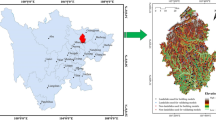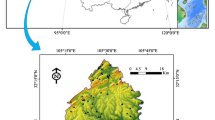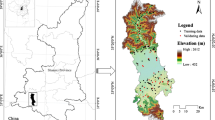Abstract
Landslide susceptibility assessment was performed using the novel hybrid model Bagging-based Naïve Bayes Trees (BAGNBT) at Mu Cang Chai district, located in northern Viet Nam. The model was validated using the Chi-square test, statistical indexes, and area under the receiver operating characteristic curve (AUC). In addition, other models, namely the Rotation Forest-based Naïve Bayes Trees (RFNBT), single Naïve Bayes Trees (NBT), and Support Vector Machines (SVM), were selected for the comparison. Results show that the novel hybrid model (AUC = 0.834) outperformed the RFNBT (0.830), SVM (0.805), and NBT (0.800). This indicates that the BAGNBT is a promising and better alternative method for landslide susceptibility modeling and mapping.












Similar content being viewed by others
References
Akgun A, Dag S, Bulut F (2008) Landslide susceptibility mapping for a landslide-prone area (Findikli, NE of Turkey) by likelihood-frequency ratio and weighted linear combination models. Environ Geol 54:1127–1143
Althuwaynee OF, Pradhan B, Lee S (2012) Application of an evidential belief function model in landslide susceptibility mapping. Comput Geosci 44:120–135
Ayalew L, Yamagishi H, Ugawa N (2004) Landslide susceptibility mapping using GIS-based weighted linear combination, the case in Tsugawa area of Agano River, Niigata Prefecture, Japan. Landslides 1:73–81
Ballabio C, Sterlacchini S (2012) Support vector machines for landslide susceptibility mapping: the Staffora River basin case study, Italy. Mathematical geosciences 44:47–70
Breiman L (1996) Bagging predictors. Mach Learn 24:123–140
Bro R, Smilde AK (2014) Principal component analysis. Anal Methods 6:2812–2831
Ermini L, Catani F, Casagli N (2005) Artificial neural networks applied to landslide susceptibility assessment. Geomorphology 66:327–343
Feizizadeh B, Roodposhti MS, Blaschke T, Aryal J (2017) Comparing GIS-based support vector machine kernel functions for landslide susceptibility mapping. Arab J Geosci 10:122
Freund Y, Schapire RE A 1995. Desicion-theoretic generalization of on-line learning and an application to boosting. In: European conference on computational learning theory, Springer, pp 23–37
Frye C (2007) About the Geometrical Interval classification method http://blogsesri.com/esri/arcgis
Hall MA (2000) Correlation-based feature selection of discrete and numeric class machine learning
Hsieh N-C, Hung L-P (2010) A data driven ensemble classifier for credit scoring analysis. Expert Syst Appl 37:534–545
Kavzoglu T, Sahin EK, Colkesen I (2014) Landslide susceptibility mapping using GIS-based multi-criteria decision analysis, support vector machines, and logistic regression. Landslides 11:425–439
Kira K, Rendell LA 1992. A practical approach to feature selection. In: Proceedings of the ninth international workshop on Machine learning, pp 249–256
Kohavi R 1996. Scaling Up the Accuracy of Naive-Bayes Classifiers: A Decision-Tree Hybrid. In: KDD, pp 202–207
Kuncheva LI (2004) Combining pattern classifiers: methods and algorithms. Wiley, Hoboken
Lee S, Sambath T (2006) Landslide susceptibility mapping in the Damrei Romel area, Cambodia using frequency ratio and logistic regression models. Environmental Geology 50:847–855
Lee S, Hwang J, Park I (2013) Application of data-driven evidential belief functions to landslide susceptibility mapping in Jinbu, Korea. Catena 100:15–30
Li C 2007. Classifying imbalanced data using a bagging ensemble variation (BEV). In: Proceedings of the 45th annual southeast regional conference, ACM, pp 203–208
Michalski RS, Carbonell JG, Mitchell TM (2013) Machine learning: an artificial intelligence approach. Springer Science & Business Media, Berlin
Murphy KP (2006) Naive bayes classifiers University of British Columbia
NCEP (2014) Global weather data for SWAT http://globalweathertamu.edu/home
Pham BT, Tien Bui D, Pourghasemi HR, Indra P, Dholakia MB (2015) Landslide susceptibility assesssment in the Uttarakhand area (India) using GIS: a comparison study of prediction capability of naïve bayes, multilayer perceptron neural networks, and functional trees methods. Theor Appl Climatol 122:1–19. https://doi.org/10.1007/s00704-015-1702-9
Pham BT, Pradhan B, Tien Bui D, Prakash I, Dholakia MB (2016a) A comparative study of different machine learning methods for landslide susceptibility assessment: a case study of Uttarakhand area (India). Environ Model Softw 84:240–250. https://doi.org/10.1016/j.envsoft.2016.07.005
Pham BT, Tien Bui D, Prakash I, Dholakia MB (2016b) Rotation forest fuzzy rule-based classifier ensemble for spatial prediction of landslides using GIS. Nat Hazards 83:1–31. https://doi.org/10.1007/s11069-016-2304-2
Pham BT, Bui DT, Prakash I (2017a) Landslide Susceptibility Assessment Using Bagging Ensemble Based Alternating Decision Trees, Logistic Regression and J48 Decision Trees Methods: A Comparative Study Geotechnical and Geological Engineering:1–15
Pham BT, Khosravi K, Prakash I (2017b) Application and comparison of decision tree-based machine learning methods in landside susceptibility assessment at Pauri Garhwal area. Uttarakhand, India Environmental Processes, pp 1–20
Pham BT, Tien Bui D, Prakash I, Dholakia MB (2017c) Hybrid integration of multilayer Perceptron neural networks and machine learning ensembles for landslide susceptibility assessment at Himalayan area (India) using GIS. Catena 149(Part 1):52–63. https://doi.org/10.1016/j.catena.2016.09.007
Pradhan B, Sezer EA, Gokceoglu C, Buchroithner MF (2010) Landslide susceptibility mapping by neuro-fuzzy approach in a landslide-prone area (Cameron highlands, Malaysia). IEEE Trans Geosci Remote Sens 48:4164–4177
Quinlan JR (1986) Induction of decision trees. Mach Learn 1:81–106
Regmi NR, Giardino JR, Vitek JD (2010) Modeling susceptibility to landslides using the weight of evidence approach: western Colorado, USA. Geomorphology 115:172–187
Rodriguez JJ, Kuncheva LI, Alonso CJ (2006) Rotation forest: a new classifier ensemble method. IEEE Trans Pattern Anal Mach Intell 28:1619–1630
Seni G, Elder JF (2010) Ensemble methods in data mining: improving accuracy through combining predictions. Synthesis Lectures on Data Mining and Knowledge Discovery 2:1–126
Sezer EA, Pradhan B, Gokceoglu C (2011) Manifestation of an adaptive neuro-fuzzy model on landslide susceptibility mapping: Klang valley, Malaysia. Expert Systems with Applications 38:8208–8219
Shirzadi A et al (2017) Shallow landslide susceptibility assessment using a novel hybrid intelligence approach. Environmental Earth Sciences 76:60
Tallarida RJ, Murray RB (1987) Chi-square test. In: Manual of Pharmacologic Calculations. Springer, pp 140–142
Tien Bui D, Ho T-C, Pradhan B, Pham B-T, Nhu V-H, Revhaug I (2016a) GIS-based modeling of rainfall-induced landslides using data mining-based functional trees classifier with AdaBoost, bagging, and MultiBoost ensemble frameworks. Environmental Earth Sciences 75:1–22. https://doi.org/10.1007/s12665-016-5919-4
Tien Bui D, Tuan TA, Klempe H, Pradhan B, Revhaug I (2016b) Spatial prediction models for shallow landslide hazards: a comparative assessment of the efficacy of support vector machines, artificial neural networks, kernel logistic regression, and logistic model tree. Landslides 13:361–378
Tsangaratos P, Ilia I (2016) Comparison of a logistic regression and naive Bayes classifier in landslide susceptibility assessments: the influence of models complexity and training dataset size. Catena 145:164–179
Vapnik VN (1995) The nature of statistical learning theory. Springer-Verlag, New York
Wang Y, Makedon F 2004. Application of Relief-F feature filtering algorithm to selecting informative genes for cancer classification using microarray data. In: Computational Systems Bioinformatics Conference, CSB 2004. Proceedings. 2004 IEEE, 2004. IEEE, pp 497–498
Wang H, Khoshgoftaar TM, Napolitano A (2012) Software measurement data reduction using ensemble techniques. Neurocomputing 92:124–132
Webb GI (2000) Multiboosting: a technique for combining boosting and wagging. Mach Learn 40:159–196
West D, Mangiameli P, Rampal R, West V (2005) Ensemble strategies for a medical diagnostic decision support system: a breast cancer diagnosis application. Eur J Oper Res 162:532–551
Wold S, Esbensen K, Geladi P (1987) Principal component analysis. Chemom Intell Lab Syst 2:37–52
Acknowledgements
The authors express their sincere thanks to the Vietnam Institute of Geosciences and Mineral Resources for providing the data and to the Director of BISAG, Gujarat, India for providing facilities for this research work.
Author information
Authors and Affiliations
Corresponding author
Rights and permissions
About this article
Cite this article
Pham, B.T., Prakash, I. A novel hybrid model of Bagging-based Naïve Bayes Trees for landslide susceptibility assessment. Bull Eng Geol Environ 78, 1911–1925 (2019). https://doi.org/10.1007/s10064-017-1202-5
Received:
Accepted:
Published:
Issue Date:
DOI: https://doi.org/10.1007/s10064-017-1202-5




